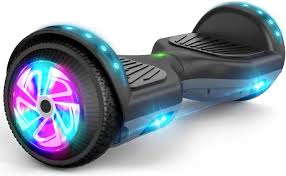Hoverboards have taken the world by storm, becoming a favorite gadget for kids, teens, and even adults. Their sleek design and ability to glide smoothly over surfaces make them incredibly fun to ride. But as with any tech gadget, there are important questions to consider before taking them out for a spin. One of the most common questions that hoverboard owners and enthusiasts ask is: Are hoverboards waterproof? Understanding this can help you take better care of your hoverboard and ensure a longer, safer ride.
What is a Hoverboard?
Before we dive into the topic of water resistance, let’s quickly review what a hoverboard is. A hoverboard is a two-wheeled, self-balancing scooter that you control with your feet. By leaning forward or backward, you can move in that direction, and by shifting your weight, you can turn. Hoverboards use motors and sensors to help you maintain balance and navigate smoothly. They are battery-powered and can reach speeds up to 10 miles per hour or more, making them a fast and efficient way to get around.
Are Hoverboards Waterproof?

Most hoverboards are not waterproof, which means they cannot be fully submerged in water or used in very wet conditions without risking damage. However, some hoverboards are water-resistant, meaning they can handle small splashes or light rain without immediate harm. Here’s a closer look at how hoverboards interact with water:
- Small Splashes and Puddles: Some hoverboards can handle light splashes or riding through small puddles. These hoverboards are usually labeled as water-resistant, but this does not mean they are completely waterproof. It’s important to check the product specifications to understand the level of water resistance.
- Heavy Rain and Submersion: Using a hoverboard in heavy rain or submerging it in water can damage its electrical components and batteries. This can cause the hoverboard to stop working and may even pose a safety hazard, such as electrical shorts or battery leaks.
- Indoor Use: Hoverboards are best used indoors or in dry conditions. This helps keep them safe from water damage and ensures they function well for a long time.
How to Protect Your Hoverboard from Water

To keep your hoverboard safe and in good working condition, follow these simple steps:
- Check the IP Rating: Some hoverboards come with an IP rating, which indicates their level of water resistance. For example, an IP54 rating means the hoverboard can handle dust and light splashes of water. The higher the number, the more protection it offers.
- Avoid Water: Try to avoid riding your hoverboard in the rain or through puddles. If the ground is wet, it’s better to wait until it dries before you ride. This simple precaution can help prevent water from seeping into the hoverboard’s sensitive components.
- Dry It Off: If your hoverboard gets wet, dry it off immediately. Use a soft, dry cloth to wipe off any water, especially around the wheels and the bottom where water might get in. This can help prevent rust and other water-related damage.
- Store It Properly: When you’re not using your hoverboard, store it in a dry place. Avoid leaving it outside where it could get wet from rain or morning dew. Proper storage is key to maintaining your hoverboard’s condition.
- Use Protective Covers: Some companies sell protective covers for hoverboards. These covers can help keep water and dirt away from the important parts of your hoverboard, offering an extra layer of protection.
Conclusion
So, are hoverboards waterproof? Most hoverboards are not, but some are water-resistant. This means they can handle small splashes or light rain, but you should avoid using them in heavy rain or submerging them in water. By taking care of your hoverboard and following these steps, you can help ensure it stays in good condition and works well for a long time. Whether you’re riding around your house or having fun outside on a dry day, knowing how to protect your hoverboard from water will help you enjoy it safely.
Frequently Asked Questions
Are hoverboards waterproof?
No, hoverboards are generally not waterproof. Most models are not designed to be fully submerged in water. However, some hoverboards are water-resistant, meaning they can handle light splashes or rain without immediate damage.
Can you ride a hoverboard in the rain?
It is not recommended to ride a hoverboard in the rain. Water can damage the electronic components inside the hoverboard, leading to malfunctions or safety hazards such as electrical shorts.
What should I do if my hoverboard gets wet?
If your hoverboard gets wet, turn it off immediately and dry it as thoroughly as possible. Remove the battery and place it in a bowl of uncooked rice to absorb moisture. Allow all components to dry completely before attempting to use it again .
How can I tell if my hoverboard is water-resistant?
Check the IP (Ingress Protection) rating of your hoverboard. An IP54 rating, for example, means it can handle light splashes and dust. The higher the second digit, the better the water resistance.
Are there any fully waterproof hoverboards available?
As of now, there are no hoverboards that are fully waterproof. Some models are marketed as water-resistant and can withstand light rain or splashes but should not be used in heavy rain or submerged in water.
What are the best practices for maintaining a hoverboard’s water resistance?
To maintain your hoverboard’s water resistance, avoid riding it in wet conditions, dry it off immediately if it gets wet, and store it in a dry place. Using protective covers can also help shield it from water and dirt.
Can water damage a hoverboard’s battery?
Yes, water can damage a hoverboard’s battery, leading to potential short circuits or battery failure. It is crucial to keep the hoverboard dry and follow proper drying procedures if it gets wet.




